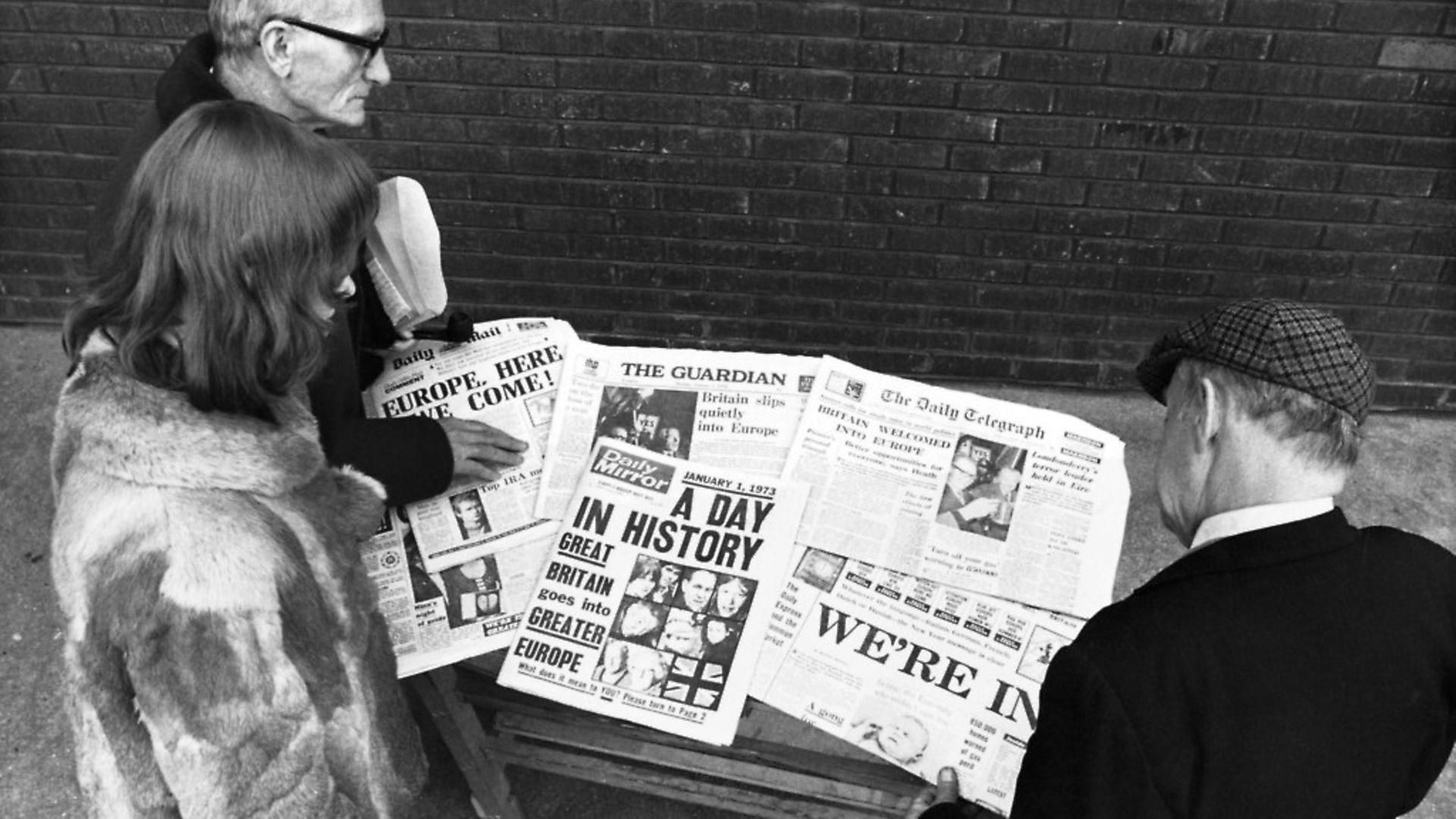
MATTHEW D’ANCONA outlines the vision behind a revolutionary journalism project designed to reflect the modern day.
If in doubt, always consult The Hitchhiker’s Guide to the Galaxy. As Douglas Adams wrote, the Earth is “an utterly insignificant little blue green planet whose ape-descended life forms are so amazingly primitive that they still think digital watches are a pretty neat idea”.
Well, that was 40 years ago, and the human race is no longer quite as impressed as it was in 1979 by digital watches. But Adams’ joke still works.
We are intrinsically bedazzled by technology, both scared and infatuated by it. If you think Bose audio frames are cool, imagine what sort of night it was 1.4 million years ago when Homo erectus first worked how to control fire. “We’re having chicken tonight!” doesn’t cover it.
The point being that what the US writer Michael Lewis calls the “New New Thing” is always, and almost by definition, overwhelming. It makes us feel simultaneously smug and intimidated.
When I joined the Times as a trainee in 1991, we all thought the Atex mainframe computer that linked the newsroom to production was pretty damn futuristic.
Yes, Rupert Murdoch’s decision to shift his operations to Wapping had been an industrial trauma and marked the end of old Fleet Street. But here we all were with flashing green screens, an internal messaging system and dot matrix printing. Talk about flash.
Within a matter of years, of course, all this was to be swept away by digital technology and a media revolution that was to make the end of hot metal, the print unions and long lunches look like a polite warm-up.
‘Move fast and break things’ used to be what parents told their children not to do. Now it is the governing principle of the huge tech corporations that dominate the daily existence of our species.
More specifically, the disruptive power of the tools they wield has overturned almost every assumption about the business of news that once seemed inviolable.
In The Poverty of Historicism, Karl Popper teaches us that all philosophies rooted in historical prophecy are useless, precisely because the progress of science is completely unknowable. And it is this lesson – common sense, really – that we all forgot.
When the internet arrived in newsrooms, it was slow, and noisy, and available only as a dial-up service. Newspaper bosses looked upon it with the unfazed interest of Raymond Baxter on Tomorrow’s World: My goodness, what will they think of next? It was generally assumed that the World Wide Web would be important, but not fundamentally so.
It would enable us to make our wares more generally available and – perhaps the biggest non sequitur in the history of commerce – encourage online readers to buy the print edition. I can even remember the internet being described in press circles as “free advertising”.
Within a matter of years that notion had proved to be the opposite of the truth. The advent of broadband and the smartphone transformed users’ consumption of everything. Meanwhile, Facebook hoovered up the advertising that had kept the nationals (just about) afloat during the price wars.
And there was more to come: much more. The proliferation of social media nurtured the view that news shouldn’t cost anything (even as we started to pay a fiver for a cup of coffee) and that – in any case – none of the traditional sources of institutional authority could be trusted.
What was true? Everything and nothing. In 2017, I published a book on ‘post truth’ and spent the year touring the world, hearing again and again that people didn’t know who or what to believe any more, that their newsfeeds were full of conspiracy theories, and that the celebrities who clustered on their screens were telling them not to vaccinate their children.
MORE: Subscribe to The New European for £25 and get a year’s subscription to Tortoise worth £100
Do I despair? Absolutely not – no more than I did when I was editor of The Spectator and saw that the digital revolution was an opportunity to launch a rolling blog on what was going on in Westminster – named ‘Coffee House’, in honour of the gossipy venues that gave birth to that great magazine in the 18th century.
I am writing this in the newsroom of Tortoise, the news platform set up by James Harding (former Times editor and BBC director of news), Katie Vanneck-Smith (former president of the Wall Street Journal and Dow Jones) and Matthew Barzun (who was US ambassador to Sweden and the UK).
Though still only in its first year of full launch, Tortoise is a thrilling place to work – multi-generational, full of intellectual and creative energy, and an exceptional pool of talent. Its early success, I think, reflects the focus of its guiding principles.
First, that it should be a membership organisation, not a subscriber service or another free-to-air news site. The core of Tortoise is the ‘ThinkIn’ – the open-source editorial conferences that we hold six times a week in the newsroom and much further afield – at which members and guests address themes that range from the Brexit crisis, to the power of individual pop songs, to the emerging science of the gut. And (the most important bit) these meetings are not just traditional media events: they inform the journalism that we go on to commission, that subsequently appears on our app.
The second commitment is to what has become known as ‘slow journalism’. To clarify: This does not mean less work for journalists, but much more. It means digging deep into the themes that underpin the surface cacophony of daily news and looking for the true dynamics that shape our world over the medium and long term.
Third: we are not afraid of priorities. Tortoise journalism focuses on five broad, principal themes: The 100-year life; wealth; belonging; new things; and our planet. This gives a structure to our work – but does not constrict it. We are as likely to feature an exploration of Kanye West’s religious identity or a celebration of the Life of Brian, as an analysis of Xi’s Hong King strategy or a photo essay on the impact of Isis in Iraq and Syria.
Unquestionably, there is a growing demand for high-quality, authoritative news, not least because we live in an era of multi-dimensional turmoil. And I also see the initial bedlam of what was called Web 2.0 settling into a more stable understanding between producers and users.
The glory of digital technology is that the means of production cost almost nothing. So the real value lies in matching what you do with what people want. And if that sounds obvious, it isn’t. For decades, most media tried to please everyone, to cover everything.
Today, the lure of clickbait remains powerful. There is a related impulse to bombard readers with data and facts, without going the extra mile in search of the connecting truth – the story, in other words.
MORE: Subscribe to The New European for £25 and get a year’s subscription to Tortoise worth £100
But much more interesting – and much more likely, I believe, to succeed in the long term – are those titles that have identified a yearning, or an opening, or public-spirited need.
The New European is a triumphant example of this phenomenon, turning the drudgery of Brexit against itself as a witty, intelligent must-read weekly. I look at gal-dem, the publication produced by women and non-binary people of colour that this week launched its fourth issue. I look at The Overtake, based in the north, a group of seriously talented young journalists producing excellent investigative work on a shoe-string.
News is irrepressible. Are there hard yards ahead of the industry? Of course. Very hard, probably. But we are diversifying, adapting, developing the anti-fragility we need to survive and prosper in a world where the only constant is change. Which, after all, is exactly as it should be. If you’re a journalist and you don’t like change, you’re probably in the wrong line of work.
And digital watches were never that brilliant, anyway…










